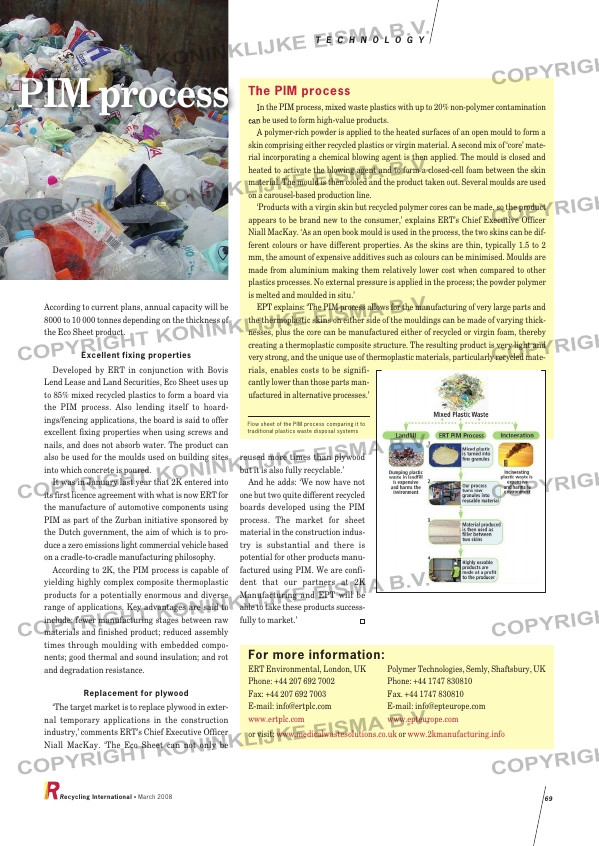Page 69 from: March 2008

According to current plans, annual capacity will be
8000 to 10 000 tonnes depending on the thickness of
the Eco Sheet product.
Excellent fixing properties
Developed by ERT in conjunction with Bovis
Lend Lease and Land Securities, Eco Sheet uses up
to 85% mixed recycled plastics to form a board via
the PIM process. Also lending itself to hoard-
ings/fencing applications, the board is said to offer
excellent fixing properties when using screws and
nails, and does not absorb water. The product can
also be used for the moulds used on building sites
into which concrete is poured.
It was in January last year that 2K entered into
its first licence agreement with what is now ERT for
the manufacture of automotive components using
PIM as part of the Zurban initiative sponsored by
the Dutch government, the aim of which is to pro-
duce a zero emissions light commercial vehicle based
on a cradle-to-cradle manufacturing philosophy.
According to 2K, the PIM process is capable of
yielding highly complex composite thermoplastic
products for a potentially enormous and diverse
range of applications. Key advantages are said to
include: fewer manufacturing stages between raw
materials and finished product; reduced assembly
times through moulding with embedded compo-
nents; good thermal and sound insulation; and rot
and degradation resistance.
Replacement for plywood
‘The target market is to replace plywood in exter-
nal temporary applications in the construction
industry,’ comments ERT’s Chief Executive Officer
Niall MacKay. ‘The Eco Sheet can not only be
reused more times than plywood
but it is also fully recyclable.’
And he adds: ‘We now have not
one but two quite different recycled
boards developed using the PIM
process. The market for sheet
material in the construction indus-
try is substantial and there is
potential for other products manu-
factured using PIM. We are confi-
dent that our partners at 2K
Manufacturing and EPT will be
able to take these products success-
fully to market.’
T E C H N O L O G Y
Recycling International • March 2008 69
The PIM process
In the PIM process, mixed waste plastics with up to 20% non-polymer contamination
can be used to form high-value products.
A polymer-rich powder is applied to the heated surfaces of an open mould to form a
skin comprising either recycled plastics or virgin material. A second mix of ‘core’ mate-
rial incorporating a chemical blowing agent is then applied. The mould is closed and
heated to activate the blowing agent and to form a closed-cell foam between the skin
material. The mould is then cooled and the product taken out. Several moulds are used
on a carousel-based production line.
‘Products with a virgin skin but recycled polymer cores can be made, so the product
appears to be brand new to the consumer,’ explains ERT’s Chief Executive Officer
Niall MacKay. ‘As an open book mould is used in the process, the two skins can be dif-
ferent colours or have different properties. As the skins are thin, typically 1.5 to 2
mm, the amount of expensive additives such as colours can be minimised. Moulds are
made from aluminium making them relatively lower cost when compared to other
plastics processes. No external pressure is applied in the process; the powder polymer
is melted and moulded in situ.’
EPT explains: ‘The PIM process allows for the manufacturing of very large parts and
the thermoplastic skins on either side of the mouldings can be made of varying thick-
nesses, plus the core can be manufactured either of recycled or virgin foam, thereby
creating a thermoplastic composite structure. The resulting product is very light and
very strong, and the unique use of thermoplastic materials, particularly recycled mate-
rials, enables costs to be signifi-
cantly lower than those parts man-
ufactured in alternative processes.’
For more information:
ERT Environmental, London, UK Polymer Technologies, Semly, Shaftsbury, UK
Phone: +44 207 692 7002 Phone: +44 1747 830810
Fax: +44 207 692 7003 Fax. +44 1747 830810
E-mail: [email protected] E-mail: [email protected]
www.ertplc.com www.epteurope.com
or visit: www.medicalwastesolutions.co.uk or www.2kmanufacturing.info
Flow sheet of the PIM process comparing it to
traditional plastics waste disposal systems
ve PIM process
RI_058 Environm Rec Techn:Opmaak 1 28-02-2008 14:38 Pagina 69



